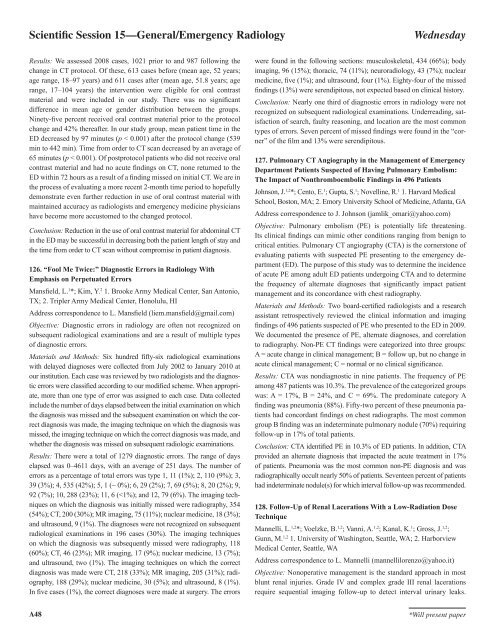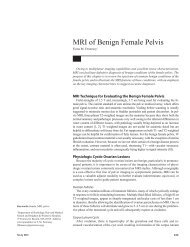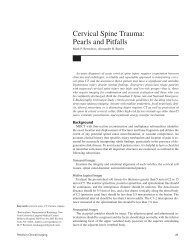<strong>Scientific</strong> <strong>Session</strong> 15—General/Emergency RadiologyWednesdayResults: We assessed 2008 cases, 1021 prior to and 987 following thechange in CT protocol. Of these, 613 cases before (mean age, 52 years;age range, 18–97 years) and 611 cases after (mean age, 51.8 years; agerange, 17–104 years) the intervention were eligible for oral contrastmaterial and were included in our study. There was no significantdifference in mean age or gender distribution between the groups.Ninety-five percent received oral contrast material prior to the protocolchange and 42% thereafter. In our study group, mean patient time in theED decreased by 97 minutes (p < 0.001) after the protocol change (539min to 442 min). Time from order to CT scan decreased by an average of65 minutes (p < 0.001). Of postprotocol patients who did not receive oralcontrast material and had no acute findings on CT, none returned to theED within 72 hours as a result of a finding missed on initial CT. We are inthe process of evaluating a more recent 2-month time period to hopefullydemonstrate even further reduction in use of oral contrast material withmaintained accuracy as radiologists and emergency medicine physicianshave become more accustomed to the changed protocol.Conclusion: Reduction in the use of oral contrast material for abdominal CTin the ED may be successful in decreasing both the patient length of stay andthe time from order to CT scan without compromise in patient diagnosis.126. “Fool Me Twice:” Diagnostic Errors in Radiology WithEmphasis on Perpetuated ErrorsMansfield, L. 1 *; Kim, Y. 2 1. Brooke Army Medical Center, San Antonio,TX; 2. Tripler Army Medical Center, Honolulu, HIAddress correspondence to L. Mansfield (liem.mansfield@gmail.com)Objective: Diagnostic errors in radiology are often not recognized onsubsequent radiological examinations and are a result of multiple typesof diagnostic errors.Materials and Methods: Six hundred fifty-six radiological examinationswith delayed diagnoses were collected from July 2002 to January 2010 atour institution. Each case was reviewed by two radiologists and the diagnosticerrors were classified according to our modified scheme. When appropriate,more than one type of error was assigned to each case. Data collectedinclude the number of days elapsed between the initial examination on whichthe diagnosis was missed and the subsequent examination on which the correctdiagnosis was made, the imaging technique on which the diagnosis wasmissed, the imaging technique on which the correct diagnosis was made, andwhether the diagnosis was missed on subsequent radiologic examinations.Results: There were a total of 1279 diagnostic errors. The range of dayselapsed was 0–4611 days, with an average of 251 days. The number oferrors as a percentage of total errors was type 1, 11 (1%); 2, 110 (9%); 3,39 (3%); 4, 535 (42%); 5, 1 (~ 0%); 6, 29 (2%); 7, 69 (5%); 8, 20 (2%); 9,92 (7%); 10, 288 (23%); 11, 6 (
Wednesday<strong>Scientific</strong> <strong>Session</strong> 15—General/Emergency RadiologyPerforming CT excretory urography as follow-up results in excessive radiationexposure. A tailored low-dose urinoma (LDU) protocol can determinewhether a persistent leak is present, but at a reduced radiation dose.The aim of this study was to compare radiation dose in patients evaluatedfor presence of urinoma using LDU versus CT excretory urography.Materials and Methods: The institutional review board approved thisstudy and waived the requirement for informed consent from patients.Forty-eight patients with grade III and IV renal lacerations (mean age, 32± 16 years) were imaged with an LDU protocol. The protocol includedlimited unenhanced and delayed enhanced scan coverage, an increasednoise index, and increased reconstruction thickness. This cohort was comparedwith 52 nontrauma patients (mean age, 56 ± 14 years) who wereimaged with a CT excretory urography protocol for nontrauma-relatedindications. In each CT examination, radiation dose was calculated usingthe dose-length product (DLP) in mGy∙cm. To control for differences inradiation dose secondary to size and tube current modulation, patient sizewas evaluated using the area of an ellipse at umbilicus. Patients weredivided in three subgroups based on abdominal size: subgroup a (small,< 449 cm 2 ), subgroup b (medium, 450–649 cm 2 ) and subgroup c (large >650 cm 2 ). In addition, results were stratified by patient age. After groupingfor patient size, the two CT protocols were compared. Statistical significancewas determined using a t test (significance, p < 0.01).Results: DLP, and therefore effective radiation dose, was significantly higher(p < 0.01) in points investigated with a CT excretory urography protocol thanan LDU protocol in all patient sizes and ages. Mean DLP ± SD in subgroupa for CT excretory urography was 1316 ± 465 mGy∙cm compared with theDLP in the LDU protocol of 447 ± 148 mGy∙cm (66% or 13.4 mSv dosesaving); for subgroup b, the values were 1896 ± 442 and 877 ± 263 mGy∙cm,respectively (53% or 15.7 mSv dose saving); and for subgroup c, the valueswere 2633 ± 593 and 1384 ± 353 mGy∙cm, respectively (47% dose saving).Conclusion: Reduced radiation with an LDU protocol study allows a significantreduction in radiation dose in patients with renal injuries beingevaluated for collecting system injury compared with traditional techniques.This is particularly important among young patients.129. MDCT of the Abdomen: Does Changing the Beam Pitch inDose-Equivalent Protocols Affect Image Quality?Husarik, D.*; Nelson, R.; Marin, D.; Richard, S.; Colsher, J.;Yoshizumi, T.; Paulson, E.; Samei, E. Duke University Medical Center,Durham, NCAddress correspondence to D. Husarik (danielahusarik@yahoo.com)Objective: To compare image quality of dose-equivalent abdominal CTimages at two different beam pitches.Materials and Methods: An adult-sized anthropomorphic phantom(CIRS) with a custom-built liver insert simulating hepatic attenuationduring the late arterial phase was used. The liver insert contained 15-mm spheres simulating hypervascular liver lesions. <strong>Imaging</strong> was performedusing a 64-section MDCT scanner (Discovery CT750 HD; GEHealthcare) with tube-voltage/tube current-time product of 120 kVp/75mAs, 100 kVp/113 mAs, 80 kVp/225 mAs, and a beam pitch of 1.375.For a beam pitch of 0.984 the tube current-time products (mAs) for thethree tube voltages were adjusted by the factor 0.984/1.375 to obtain doseequivalent studies. Each acquisition was repeated three times for statisticalpurposes. For quantitative image analysis, the attenuation (HU) of theliver lesions and surrounding liver were measured. Noise estimates werederived from the surrounding liver. Lesion-to-liver contrast-to-noise ratios(CNRs) were calculated. CNRs and image noise were compared betweendifferent beam pitches for each tube voltage using a paired Studentt test; a p value less than 0.05 was considered significant.Results: The CNR values for a beam pitch of 1.375 and 0.984 were 0.88± 0.26 and 1.00 ± 0.21 at 120 kVp, 1.00 ± 0.33 and 1.15 ± 0.15 at 100kVp, and 1.53 ± 0.10 and 1.44 ± 0.35 at 80 kVp, respectively. CNR valuesdid not differ significantly between different beam pitches (p > 0.3).Image noise for a beam pitch of 1.375 and 0.984 was 16.58 ± 0.48 HUand 18.73 ± 0.54 HU at 120 kVp, 17.6 ± 2.0 HU and 18.5 ± 1.7 HU at100 kVp, and 20.5 ± 1.8 HU and 21.4 ± 0.9 HU at 80 kVp, respectively.Significantly lower image noise was only found for a beam pitch of 1.375compared with 0.984 at 120 kVp (p < 0.005). Image noise did not differsignificantly between the two beam pitches at 100 kVp and 80 kVp.Conclusion: Changing the beam pitch has no significant effect on theCNR when using dose-equivalent CT protocols in the abdomen.130. High Pitch, Dual-Source CT of the Abdomen and Pelvis:A Feasibility StudyMayes, N.*; Hardie, A. Medical University of South Carolina, NorthCharleston, SCAddress correspondence to N. Mayes (mayesnick@hotmail.com)Objective: Rapid CT scan acquisition is essential to limiting motion artifacts.One method of increasing the acquisition speed is to increase pitch(table distance traveled per rotation). However, studies evaluating the effectof higher pitch imaging using single-source CT scanners have foundpoorer image quality (Sahani D. Comparison between low [3:1] and high[6:1] pitch for routine abdominal/pelvic imaging with multislice computedtomography. J Comput Assist Tomogr 2003; 27:105–109). Dual-source CTmay allow for increased pitch without as significant an impact on the image.The purpose of our study was to retrospectively compare high-pitch,dual-source CT (HDCT) with standard single-source CT of the abdomenand pelvis with regard to overall image quality and image noise.Materials and Methods: Seventy-nine CT examinations between Januaryand May 2010 were identified, including 34 patients who underwent singlesourceCT and 45 who underwent HDCT. All patients had undergone oraland IV contrast-enhanced CT of the abdomen and pelvis in a single pass.The mean pitch of dual-source CT was 2.5 versus 0.6 for single-source CT.Image quality was evaluated by two blinded board-certified radiologists ona 5-point scale (1, nondiagnostic; 2, poor or significantly limited; 3, goodor slightly limited; 4, very good or no significant limitation; and 5, excellent,highest diagnostic quality). Statistical significance was assessed byMann-Whitney U test. Quantitative image noise analysis was performedby the mean ± SD of a region of interest (Hounsfield unit [HU]) over thepsoas muscles with statistical significance assessed by Student t test.Results: There was no significant difference in mean noise betweenHDCT (12.6 HU) and single-source CT (12.0 HU) (p = 0.2). Oneof the two readers had a significantly lower perceived imaging quality ondual-source CT (p ≤ 0.01), while the other had no difference (p = 0.36).*Will present paperA49
















